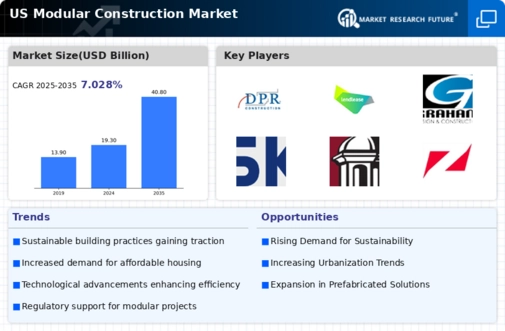Cost Efficiency in Construction
The modular construction-high-rise-buildings market is experiencing a notable shift towards cost efficiency. Modular construction techniques can reduce overall project costs by up to 20% compared to traditional building methods. This reduction is primarily due to decreased labor costs and shorter construction timelines. As labor shortages persist in the construction industry, the appeal of modular construction becomes more pronounced. Additionally, the ability to produce building components in a controlled factory environment minimizes waste and enhances quality control. This cost efficiency is particularly attractive to developers and investors because it allows for quicker returns on investment. Consequently, the trend towards cost-effective building solutions is likely to drive growth in the modular construction-high-rise-buildings market, as stakeholders seek to maximize profitability while minimizing expenses.
Regulatory Support and Incentives
Regulatory frameworks and government incentives are playing a crucial role in the modular construction-high-rise-buildings market. Various state and local governments are increasingly recognizing the benefits of modular construction, leading to the introduction of supportive policies. For instance, some jurisdictions offer tax incentives or expedited permitting processes for modular projects. These measures aim to encourage sustainable building practices and address housing shortages. According to recent data, states that have implemented such incentives have seen a 15% increase in modular construction projects. This regulatory support not only fosters innovation but also enhances the market's attractiveness to developers. As more regions adopt favorable regulations, the modular construction-high-rise-buildings market is poised for significant expansion.
Increased Demand for Affordable Housing
The rising demand for affordable housing is a significant driver for the modular construction-high-rise-buildings market. With housing prices escalating in urban areas, there is a pressing need for cost-effective housing solutions. Modular construction offers a viable alternative, allowing for the rapid assembly of affordable units. Recent studies indicate that modular homes can be built at a cost of approximately $100,000 to $150,000, significantly lower than traditional homes. This affordability, combined with the ability to construct units quickly, makes modular construction an attractive option for developers and municipalities aiming to address housing shortages. As the need for affordable housing continues to grow, the modular construction-high-rise-buildings market is expected to expand to meet this demand.
Technological Integration and Innovation
The integration of advanced technologies is transforming the modular construction-high-rise-buildings market. Innovations such as Building Information Modeling (BIM) and 3D printing are streamlining the design and manufacturing processes. These technologies enable precise planning and reduce errors, which can lead to cost savings of approximately 10-15% during construction. Furthermore, the use of smart building technologies enhances operational efficiency and sustainability, appealing to environmentally conscious consumers. As the demand for technologically advanced buildings grows, the modular construction sector is likely to adapt and innovate continuously. This technological evolution not only improves project delivery times but also positions the modular construction-high-rise-buildings market as a leader in modern construction practices.
Sustainability and Environmental Considerations
Sustainability is becoming increasingly important in the modular construction-high-rise-buildings market. As environmental concerns rise, builders are seeking methods to reduce their carbon footprint. Modular construction inherently supports sustainability through reduced waste and energy-efficient building practices. It is estimated that modular construction can decrease material waste by up to 30% compared to traditional methods. Additionally, the ability to incorporate sustainable materials and energy-efficient systems during the manufacturing process enhances the overall environmental performance of buildings. This focus on sustainability not only meets regulatory requirements but also appeals to a growing segment of environmentally conscious consumers. As sustainability becomes a priority, the modular construction-high-rise-buildings market is likely to see increased investment and growth.




















Leave a Comment